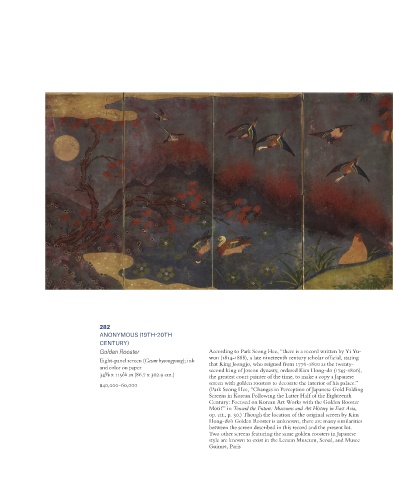Page 444 - japanese and korean art Utterberg Collection Christie's March 22 2022
P. 444
282
ANONYMOUS (19TH-20TH
CENTURY)
Golden Rooster According to Park Seong Hee, “there is a record written by Yi Yu-
Eight-panel screen (Geum byeongpung); ink won (1814-1888), a late nineteenth century scholar official, stating
that King Jeongjo, who reigned from 1776-1800 as the twenty-
and color on paper second king of Joseon dynasty, ordered Kim Hong-do (1745-1806),
34¿ x 119º in (86.7 x 302.9 cm.) the greatest court painter of the time, to make a copy a Japanese
$40,000-60,000 screen with golden roosters to decorate the interior of his palace.”
(Park Seong Hee, “Changes in Perception of Japanese Gold Folding
Screens in Korean Following the Latter Half of the Eighteenth
Century: Focused on Korean Art Works with the Golden Rooster
Motif” in Toward the Future: Museums and Art History in East Asia,
op. cit., p. 30.) Though the location of the original screen by Kim
Hong-do’s Golden Rooster is unknown, there are many similarities
between the screen described in this record and the present lot.
Two other screens featuring the same golden roosters in Japanese
style are known to exist in the Leeum Museum, Seoul, and Musee
Guimet, Paris

